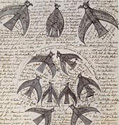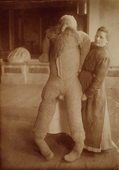I am sending with this, 3 page drawings. Thank you so much for the paper. Take a look at the letter if you have time…
I have decided upon – Träume u. Schäume (Dreams and Foams) – or Schweisstropfen (Drops of Sweat) as a title. I hope you see the picture better than I, because I do not comand the time to look at it more closely.
With best wishes Ernst Bernhardt -“
One might have heard about The Prinzhorn Collection once, but forgot again – just to be reminded by an arte documentation about this extraordinary anthology of expressions of human inside movements and disturbances. In his recent film documentary film maker Christian Beetz got access to one of the world’s largest collection of artwork by schizophrenic patients: The collection of Prinzhorn revolutionized the bigoted viewpoint in psychiatry as well as the art world of the 1920´s. Artists such as Paul Klee, Alfred Kubin and Max Ernst were highly inspired by the so-called “insane artâ€. Later, these modern artists were found together with parts of the collection of Prinzhorn in the “Degenerate Art†exhibition by the Nazis. The film follows the history of the Prinzhorn collection illustrating the inner conflicts of the schizophrenic patients through their artwork.
Thus from here on I let the collection speak for itself:
| During its search for authentic art at the beginning of the Twentieth Century, the Modern movement discovered not only “primitive art” and children’s drawings, but also “psychotic art”. Simultaneous to this a number of psychiatrists began eagerly collecting their patients’ pictorial works, although this was principally in the hope that these could be used to assist diagnosis.Hans Prinzhorn (1886-1933), who as an art historian and doctor was versed in both fields, is regarded nowadays as having pioneered an interdisciplinary approach. He was interested in questions of cultural anthropology, such as the origins of the artistic impulse, or the “schizophrenic sense of existence” he witnessed in contemporary Expressionist art. And he hoped to gain direct, primal insight into these questions through the patients’ works. During the years after the First World War, he built up with the support of Karl Wilmanns, the head of the Psychiatric Department in Heidelberg, a unique collection of works from psychiatric hospitals. His richly illustrated book The Artistry of the Mentally Ill (Berlin 1922) not only documented the collection, but partly interpreted it and contextualised it through a critical examination of the prevailing culture. |    |
| Here he departed once and for all from any questions about the relevance of the works for diagnostics. Instead, he emphasised that all of these creative phenomena are equally valid in psychological terms, and that some have recognisably artistic quality – thus allowing this disparaged “insane art” and its creators to be given a positive re-evaluation. Prinzhorn’s great achievement was, in effect, to open up the blinkered viewpoint of psychiatry to include the realms of both art and art history. This was a courageous step which, in the long term, helped the patients’ creative production receive its just acclaim and to promote a reintegration of the patients into society. | |
See also the lacanian ink link about an earlier exhibition.
